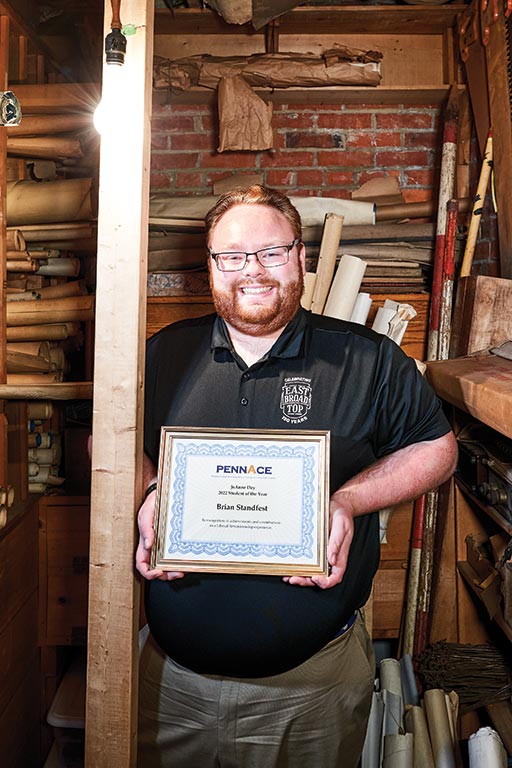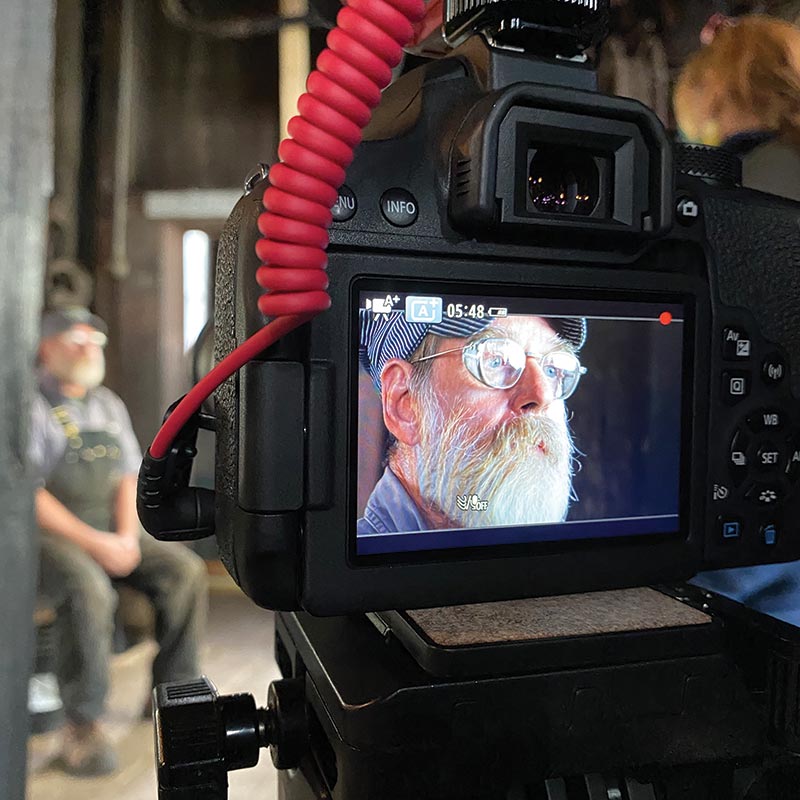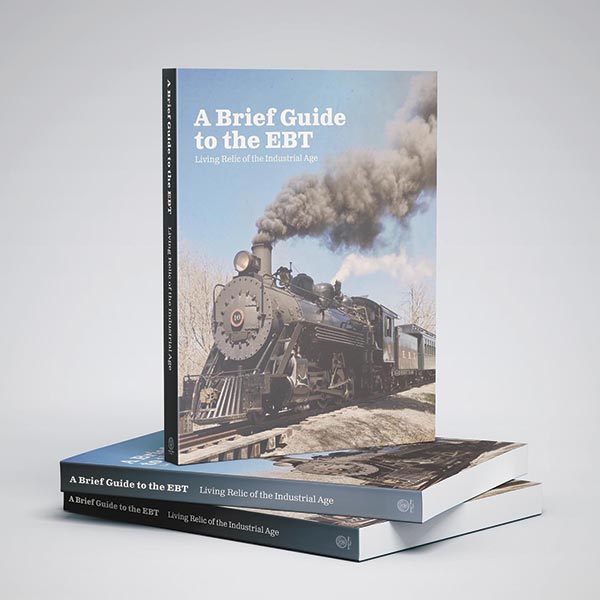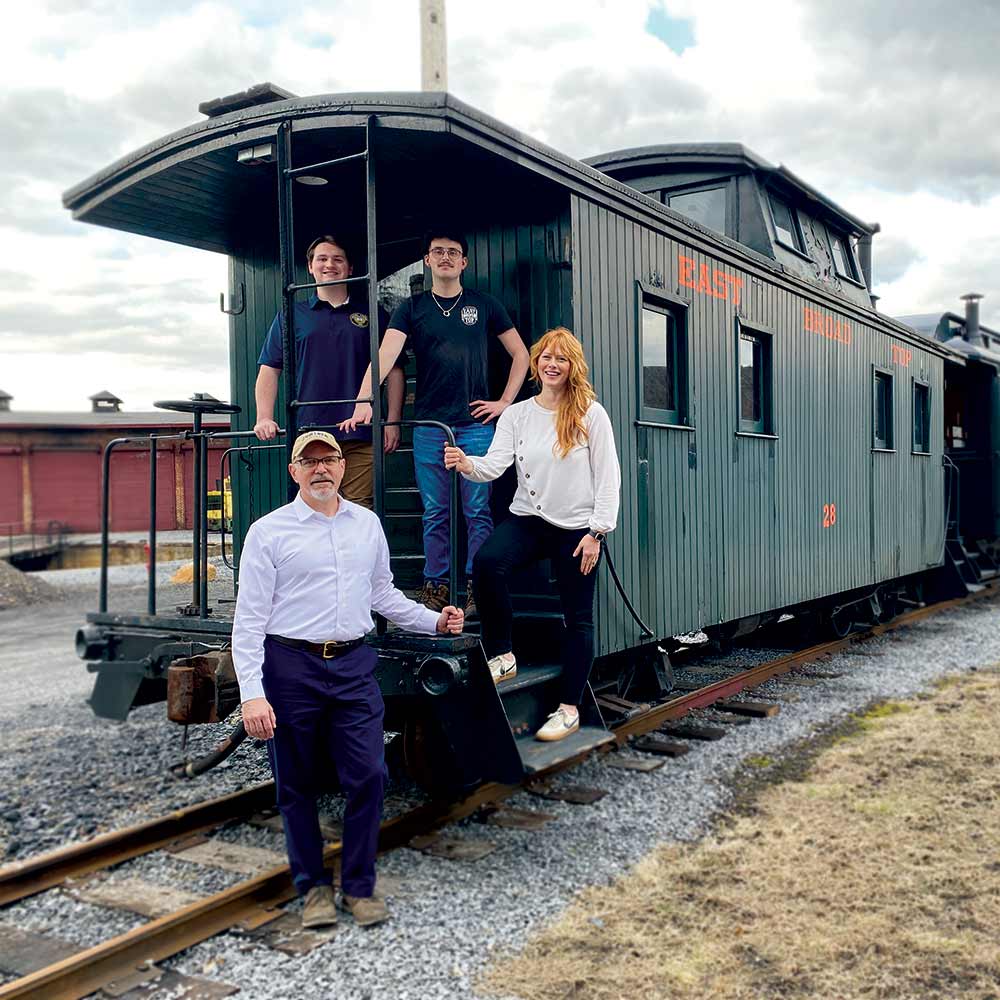These days it’s no surprise that colleges want students to spend some time putting into practice what they’ve learned in classes. But it is a surprise when a historic narrow-gauge steam railroad teams up with a liberal arts college and its students produce a 116-page guidebook, a 15-minute video documentary, and a semester-long museum exhibit — in addition to serving as interns in the railroad’s just-established archives program.
That’s what has happened since early 2020, when a new nonprofit foundation acquired the East Broad Top Railroad (EBT), a National Historic Landmark about a half an hour south of Juniata in Huntingdon County. The railroad is known for its handsome steam locomotives and its intact circa-1910 machine-shop complex, but it had been closed since the end of 2011, and many of its fans had doubted it would ever reopen.
Now, four years later, trains are again carrying passengers behind EBT steam locomotive No. 16. And Juniata students and faculty members have been involved with the railroad in ways that have benefited the EBT and given students unique opportunities.
Students in a special history course, for instance, researched and wrote much of a brand-new guidebook for visitors to the railroad — a guidebook that was designed and laid out by students in two Integrated Media Arts classes. IMA students also produced a memorable video about the railroad’s reopening, and students in two museum studies courses organized and mounted a popular 2022 exhibit about the railroad at the Juniata College Museum of Art.
“The history really fascinated me,” said Sammy Bellin ’22. Bellin was among the students invited to the guidebook class by Jim Tuten, Charles R. and Shirley A. Knox Professor of History. “It’s great reading about wars and great historical events,” Bellin said, “but this is very in-depth history that I could relate to.” Among his articles for the guidebook are accounts of the local iron, coal, and tanning industries, of passenger service, and of the EBT’s most influential president.
“Visiting the East Broad Top Railroad as a part of our initial research was such an amazing experience,” said Emily Kaltenbaugh ’23, project manager for the IMA team that designed and laid out the 116-page, heavily illustrated guidebook. “Getting to see the buildings and the archives in person made me excited to design with that history in mind.”
Kaltenbaugh said having the railroad as the design client in a practicum taught by Ryan Kough, associate professor of Integrated Media Arts, was invaluable. “Rather than mock-up page layouts for a final project, we got to mock-up pages, make edits, and hold a final product in our hands. That’s something special.”


Beyond the courses that worked with the railroad, three Juniata students have had summer internships in the EBT’s new Archives and Special Collections program, where they’ve made tremendous contributions. The first was Bellin, who was the first archives intern and was hired as the railroad’s archives technician after graduating. Brian Standfest ’23, a second intern, was subsequently hired for a full-time archives job elsewhere.
Third intern Connor Green ’24 organized thousands of EBT maps and drawings during the summer of 2023. A fourth Juniata intern is expected this summer.
“The Juniata relationship is one of the great things that has happened” since the EBT reopened, said Henry Posner, III, who is board chair of the EBT Foundation, Inc., and chairman of the Rail Development Corp., based in Pittsburgh. “I think it’s logical that we would partner with the preeminent academic institution in the region,” said Posner, who also teaches one course a year at Carnegie Mellon University. “It came together in a very natural and fruitful way.”
The East Broad Top is an unusual survivor among railroads. It was built from 1872 to 1874 to bring coal from mines on the Broad Top to a new, high-tech iron furnace near the Blacklog Narrows. The elevation of the coal mines, however, required surveyors to plan a route that twists and turns as it claws its way up the mountainsides, plunging into one tunnel and looping back on itself before plunging into another. To save money during construction, the investors decided to build the line narrow gauge, with rails three feet apart instead of 4’ 8 ½”, which was then well on its way to becoming the standard gauge for American railroads.
The advantage of 36-inch gauge was that its smaller equipment could negotiate sharper curves, so the line could be routed around obstacles instead of having to be dug through them. The disadvantage was that EBT cars couldn’t run on the tracks of the Pennsylvania Railroad, which the EBT met in Mount Union. This was to have interesting implications later — implications you can read about in the guidebook.
In 1908, with steel supplanting cast iron, the Rockhill [iron] Furnace closed. The railroad thrived, however, by concentrating on moving Broad Top coal, which was advertised as “smokeless” and sold well though World War II. By 1956, however, demand for the coal had all but evaporated, and the EBT ran its final common-carrier trains in early April. The property was sold to an Indiana, Pa., salvage dealer, Nick Kovalchick, presumably for scrapping.
But that never happened. In 1960, Kovalchick reopened about four miles of the East Broad Top as one of the nation’s first tourist railroads, catering to the nostalgia that people who had grown up with steam railroading felt as diesel locomotives took over. The move was an immediate success, and the railroad was soon designated a National Historic Landmark. In 1983, a handful of model railroaders created the Friends of the East Broad Top, an all-volunteer group that eventually began working not on models but on real EBT buildings and cars, as well as on evangelizing on the railroad’s behalf.
Nick Kovalchick’s son Joe continued the tourist operation, but in the 1990s he began looking for a buyer. When none had appeared by the end of the 2011 season, he closed the railroad but allowed volunteers of the Friends of the East Broad Top to continue preservation efforts. In 2018, a Juniata alumnus who had grown up near the EBT, Stephen Lane ’18, was among a handful of people who worked with a longtime Friends member, Brad Esposito, on creating a nonprofit to acquire the railroad. Along with Posner, two other key players brought in by Esposito were Wick Moorman, a former president of Norfolk Southern and of Amtrak, and Bennett Levin, an influential rail-preservation advocate from Philadelphia. In early 2020, the new EBT Foundation, Inc., acquired the East Broad Top.

That summer Tuten devised the course aimed at creating a new guidebook for the railroad, which had been relying on a historic booklet since 1979. A book written about the Durango & Silverton Narrow Gauge Railroad, in Colorado, offered a model that incorporated history, geology, and a description of the route, so Tuten recruited not only history students but also students studying English, environmental science, and geology. Complicating the effort was the COVID pandemic, which placed strict limits on travel — but trips within the county were allowed. “I wasn’t sure how much students would get interested in the story of a historic railroad, but especially after we came to visit, they were hooked,” Tuten said. “They’re not ever going to see trains the same way again.”
Kough’s IMA students were hooked, too. Tuten had suggested bringing Kough into the project to handle designing the book, but as soon as she brought students to visit the railroad, Kough said, “everyone on that team saw the potential to capture oral histories — it’s a living and working and breathing museum.” Three students, Ashley Purvis ’21, Hayley Purvis ’21, and Tatum Poirier ’21, quickly began recording the interviews that make up their documentary, “The East Broad Top Way” (https://tinyurl.com/EBTdoc).

While the book was in the editing phase, another project developed. The railroad and the Friends had come together to hire an archivist, Julie Fether Rockwell, whose first task was to figure out how much archival material the EBT had and what shape it was in. With help from Bellin, the first archives intern, she was able to estimate that the railroad alone had some 5,000 linear feet of maps, drawings, correspondence, board minutes, and so forth, almost of it in good condition and almost all of it unseen for decades. That led to conversations with Kathryn Blake, director of Juniata’s Museum of Art, about the possibility of an exhibit, which Blake suggested could be organized and mounted by museum studies students as a real-world challenge. The exhibit, in fall 2022, included photos, tools, locomotive inspection records, train orders, and even a scale model of the EBT shops borrowed from the Bricktown Model Railroaders Association in nearby Mount Union. It drew many visitors who had never been to the museum before, Blake said.
Standfest, who worked with Rockwell and Bellin in the summer of 2022 as the second archives intern, said that if he hadn’t spent that time at the EBT, he might not have been hired for his current job at the Army National Heritage and Education Center in Carlisle, Pa., where, “I’ve learned new skills but also used skills Julie and Sammy showed me during my internship,” he said. “Reading theory is important in any field, but it is equally or more important being able to apply the theory to real-world practice. I was lucky to work with Julie on handling various artifacts and documents to help care for and preserve them.”

After several delays, “A Brief Guide to the EBT: Living Relic of the Industrial Age” went to the printers in fall 2023, in an unusual collaboration. The college revived its Juniata College Press to be the new volume’s official publisher, and the Friends of the EBT financed the printing and is handling distribution through its online company store. “The EBT is an abundant source of fascinating tales that bring life to the site and machinery,” said Andy Van Scyoc, the Friends president, of the guidebook project. “The Juniata students have captured a delightful sampling of these stories to provide an enticing entry into the rich EBT legacy.”
“Once it had been sent to the printers and we were waiting for it to arrive,” said Tuten, “I felt a particular pride about this work — more than I’ve felt about almost any other teaching I’ve done. I know lots of colleagues around the nation who never get to do a project like this that grew and featured the talents of Juniata students.”





